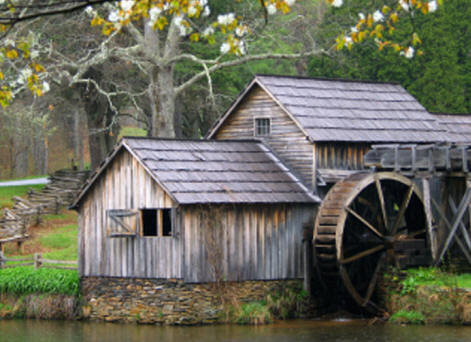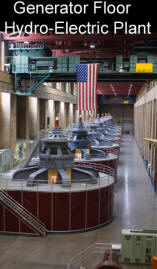Generators - How They
Make Energy
Making
Energy: How a Generator Works
Whether you use fossil fuels or an alternative form of energy, one of the
key components of the process is usually a generator.
Without a generator, you cannot produce electrical energy -
you can only produce mechanical energy. For
example, when flowing water moves a waterwheel, this is
mechanical energy. The waterwheel was sometimes
used hundred of years ago in mills to directly crush
grains by connecting the wheel moved by water through a
serious of gears to a mechanism that did the crushing
work.
However, by using a generator, we can create the same amount of
power, but store it and send it to homes to use for
heat, light, and operating anything that needs to be
plugged into the wall.
By using the waterwheel example, generators are easy to understand.
They work in much the same way with other forms of
energy as well.
|

Everything
starts with a turbine of some sort. In a water
wheel, the wheel that is being pushed by the flowing
river or waterfall acts as the turbine blades.
Basically, whatever process you are using, the blades are the parts
that spin. The turbine is connected to a shaft,
which also spins and causes the rotor to spin as well.
The rotor is made up of a series of large electromagnets
and is found inside a stator, or roll of copper
wire. The electrical charge is created by the
interaction between the copper wire and magnets.
This current can then be sent as electricity to do work
in homes.
Generators work in a similar way when using wind power, except the
moving air causes blades to spin, rather than
water.
In other forms of energy, where steam is created, such as
geothermal energy, nuclear energy, and ocean thermal
energy conversion, the air expands from the heat of
the boiling liquid and this moving air turns the
turbine.
 This is also how fossil fuels work. The process of using turbines and
generators itself does not cause pollution. Rather,
it is the by-product from the chemical reaction used to
produce the steam that turns the turbine (in this case,
burning fossil fuels like oil and coal). This is also how fossil fuels work. The process of using turbines and
generators itself does not cause pollution. Rather,
it is the by-product from the chemical reaction used to
produce the steam that turns the turbine (in this case,
burning fossil fuels like oil and coal).
Therefore, using generators to create electricity with alternative
forms of energy is clean and safe for the environment.
As this process becomes more efficient and cost-effective, using water
and wind turbines could become more popular to create
energy for the world's power supply. |
TOPICS
◙
Renewable Energy -
Saving our Earth
◙
Building a Green Home
◙
Wind Power
-
Advantages
◙
Solar Cells - How
they Work
◙
Biofuel as an
Alternative
◙
Ethanol - Gas of the
Future
◙
Hybrid Vehicles
◙
Generators - How
they Work
◙
The Greenhouse Effect
◙
The Future of
Hydrogen Energy
◙ Geothermal Energy
◙
Tax Incentives
◙
Goodbye Fossil
Fuels? |

